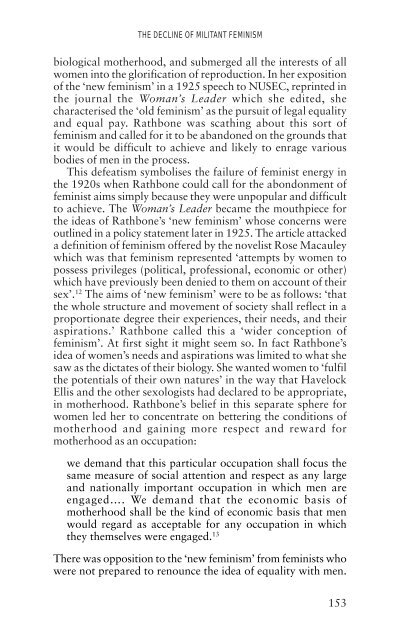The Spinster and Her Enemies - Feminish
The Spinster and Her Enemies - Feminish
The Spinster and Her Enemies - Feminish
Create successful ePaper yourself
Turn your PDF publications into a flip-book with our unique Google optimized e-Paper software.
THE DECLINE OF MILITANT FEMINISM<br />
biological motherhood, <strong>and</strong> submerged all the interests of all<br />
women into the glorification of reproduction. In her exposition<br />
of the ‘new feminism’ in a 1925 speech to NUSEC, reprinted in<br />
the journal the Woman’s Leader which she edited, she<br />
characterised the ‘old feminism’ as the pursuit of legal equality<br />
<strong>and</strong> equal pay. Rathbone was scathing about this sort of<br />
feminism <strong>and</strong> called for it to be ab<strong>and</strong>oned on the grounds that<br />
it would be difficult to achieve <strong>and</strong> likely to enrage various<br />
bodies of men in the process.<br />
This defeatism symbolises the failure of feminist energy in<br />
the 1920s when Rathbone could call for the abondonment of<br />
feminist aims simply because they were unpopular <strong>and</strong> difficult<br />
to achieve. <strong>The</strong> Woman’s Leader became the mouthpiece for<br />
the ideas of Rathbone’s ‘new feminism’ whose concerns were<br />
outlined in a policy statement later in 1925. <strong>The</strong> article attacked<br />
a definition of feminism offered by the novelist Rose Macauley<br />
which was that feminism represented ‘attempts by women to<br />
possess privileges (political, professional, economic or other)<br />
which have previously been denied to them on account of their<br />
sex’. 12 <strong>The</strong> aims of ‘new feminism’ were to be as follows: ‘that<br />
the whole structure <strong>and</strong> movement of society shall reflect in a<br />
proportionate degree their experiences, their needs, <strong>and</strong> their<br />
aspirations.’ Rathbone called this a ‘wider conception of<br />
feminism’. At first sight it might seem so. In fact Rathbone’s<br />
idea of women’s needs <strong>and</strong> aspirations was limited to what she<br />
saw as the dictates of their biology. She wanted women to ‘fulfil<br />
the potentials of their own natures’ in the way that Havelock<br />
Ellis <strong>and</strong> the other sexologists had declared to be appropriate,<br />
in motherhood. Rathbone’s belief in this separate sphere for<br />
women led her to concentrate on bettering the conditions of<br />
motherhood <strong>and</strong> gaining more respect <strong>and</strong> reward for<br />
motherhood as an occupation:<br />
we dem<strong>and</strong> that this particular occupation shall focus the<br />
same measure of social attention <strong>and</strong> respect as any large<br />
<strong>and</strong> nationally important occupation in which men are<br />
engaged…. We dem<strong>and</strong> that the economic basis of<br />
motherhood shall be the kind of economic basis that men<br />
would regard as acceptable for any occupation in which<br />
they themselves were engaged. 13<br />
<strong>The</strong>re was opposition to the ‘new feminism’ from feminists who<br />
were not prepared to renounce the idea of equality with men.<br />
153

















